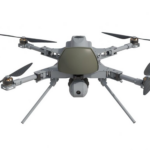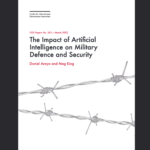AI and 5G – Getting Smart About AI and 5G in Canada

Table of Contents
Canada has been investing in machine learning and artificial intelligence (AI) for longer than most of the industrialized world. Dr. Geoff Hinton of Google helped ignite the field of graphics processing unit (GPU) deep learning at the University of Toronto. Then he became chief scientific advisor to the Vector Institute, which in collaboration with the University, aims to produce the largest number of deep learning AI graduates and innovators globally. Meanwhile, Montreal, Quebec prides itself as the birthplace of AI. It’s the home of computer scientist Yoshua Bengio, who is another pioneer of AI technology. Hundreds of AI researchers and doctoral students are concentrated at McGill University and the University of Montreal. I wrote more about innovation in Canada here. To benefit from the AI innovation, Canada should focus on developing 5G and AI in tandem.
A Supercluster Strategy on AI
By 2017, the Canadian government pledged $1.3 billion for AI R&D and is developing a national AI strategy designed to attract skilled tech workers and researchers, and establish hubs for AI research and development in Edmonton, Montreal, Toronto, Vancouver and Waterloo. Some 35 corporate sponsors are on board at the Vector Institute, which is also funded by the Government of Ontario. Nvidia announced a $5M investment early on and other partners include Telus, Accenture and ScotiaBank. Separately, General Motors moved its AI labs across the border to Toronto.
The Canadian ‘supercluster’ strategy now encompasses over 250 partner organizations, and supports collaboration among academics, entrepreneurs and enterprises. In one medical use case, researchers at the University of Alberta in Edmonton have developed a diagnostic platform that uses AI and a drop of blood to detect prostate cancer, which may eliminate the need for hundreds of thousands of intrusive biopsies.
Canadian entrepreneurs have launched dozens of exciting AI startups operating across the retail sales/CRM, healthcare, education, SaaS and IoT sectors. Both the government of Canada and corporate sponsors such as Google and Nvidia support many of these companies. Some examples include: Element AI and integrate.ai (both in AI software as a service), Dessa (AI platform), Invenia (electric power), MindBridge (auditing), Crowdcare (chatbot), Cyclica (pharma research), ideal (HR recruiting), naborly (tenant screening), and Iceberg (hockey). Nanalyze highlights more top AI startups in Canada annually, and Ontario spotlights the many AI companies based in its province alone.
In all its current incarnations, AI is best thought of as greatly augmenting human intelligence. Using massive data sets, it can detect important patterns and make specific, narrow forecasts, predictions or diagnoses that humans alone cannot. Amazing AI tools in industry and medicine, however, are no substitute for human judgment on complex issues, and typically do not make decisions independently of human controls, except perhaps directing what online ads to serve to whom.
Dependence on 5G Network Infrastructure
As explained in a recent post, development of AI capabilities and fifth generation wireless (5G) network connectivity are intertwined because widespread optimal use of each technology will be impossible without local (5G) or regional (AI) availability of and access to the other. In an almost ‘chicken and egg’ scenario, 5G is needed to enable use of AI at scale and demand for AI is needed to build the business case for the huge investment 5G networks require. The marriage of these two technologies, along with a massive scaling up of the Internet of Things (IoT) is a prerequisite for the next technological revolution. While the technology building blocks have already been developed, sufficient public and private commitment and investment are often lacking…except in China.
5G networks are complex and dynamic with massive capacity for transmitting data with low latency, but the upfront need to build out expensive new physical network infrastructure including both hardware and software components, is daunting. Once switched on, 5G networks will support many new applications responding in real time to changing needs and conditions, but operating these networks will be impossible without robust baked-in machine learning capability.
To deliver on promises like truly low latency, network traffic and planning will need to be handled precisely and efficiently in real time. This advanced network management is imperative for the safe and reliable operation of industrial IoT and autonomous vehicles. Network slicing, one of the most exciting unique features of 5G, will require greater automation and intelligent configuration to be effective.
5G networks will provide greater access to cloud data storage, the ability to run enterprise applications and the compute power to run more tasks virtually. It also opens the possibility of 100x more device connections, which is why it’s key to automated factories, supply chains and IoT at scale. 5G networks will require responsive processing of inconceivably large amounts of data. Humans can’t do that job. Neither can rules-based systems when various use cases and network slices are taken into account. So that will fall to AI.
The World Economic Forum recognizes both Canada’s shortcomings and its growth in overcoming them. Canada ranks 14th for the availability of latest technologies; 9th for the quality of scientific research institutions and 4th for availability of scientists and engineers. It also ranks 8th for the quality of its higher education. While these standings are not impressive among OECD countries or compared to China for that matter, they are pretty solid globally and are on an upswing.
World class Talent in AI Will Lead to Demand for 5G
Google, IBM and Microsoft have been accused of hoarding AI talent, both for academic research and industrial innovation, with companies like GE and Samsung following suit. But the ‘brain drain’ to the U.S. has slowed or even reversed itself. The Trump Administration’s lack of emphasis on scientific research in general and on concrete AI and 5G initiatives in particular is a key driver of northward migration for AI professionals. And Canadians have conducted mission trips to Europe as well as Silicon Valley specifically to recruit AI specialists.
In response to increasingly restrictive U.S. immigration policies, tech companies are eager to leverage the anxiety among international students and visa holders to find them a professional home north of the border. International applications to Canadian universities rose 25% in 2017, with a much higher percentage increase at the University of Toronto. At the same time, the Canadian government has taken steps to make it easier for highly skilled workers to move “up” from the U.S.
The more innovative AI tools are developed by Canadian hubs and offer obvious practical business advantages, the more enterprises will demand 5G connectivity to enable implementation of those AI solutions at scale. Perhaps Canadian telecoms should approach experts in the AI hub cities about collaborating on a local/regional business case for 5G build out and deployment.
The government of Canada has begun to use AI in the delivery of programs and public services that do not necessarily require 5G. It highlights the need to conduct automated decision-making responsibly according to “clear values, ethics and laws.” Transparency and training are among the essential principles it follows. It has posted a short video on algorithmic impact assessment.
FatML is an annual conference that brings together researchers and practitioners, including corporate sponsors that are concerned with fairness, accountability and transparency in machine learning, given the recognition that ML raises novel ethical challenges in both the public and private sectors. It held its August 2017 event in Halifax, Nova Scotia.
Recently, the Canadian Chamber of Commerce made recommendations to Ottawa about raising awareness of AI technology, relevant social inclusion concerns, regulatory certainty and the need to support 5G infrastructure: “The government should adopt policies and provide incentives to ensure there is 5G infrastructure put in place across Canada. The government should play a role in closing potential 5G infrastructure gaps, especially in rural and remote areas.” The biggest hurdle is that 5G’s small cells and dense network configuration mean that covering broad geographies will be exponentially more expensive for ISPs than it is in urban environments.
Tech Influx and Enlightened Public Policy Helps
An increasing number of world-class tech companies have established a greater presence in Canada. PwC opened a state of the art digital experience centre in Toronto where it can work with experts from diverse industries to help clients embrace emerging technologies and develop innovative solutions to their business needs. The space enables PwC employees and clients to test how technologies like AI, virtual reality, IoT and robotics can bring greater efficiency to their businesses.
Another positive in the industrial policy approach of Canada’s government is support for domestic tech manufacturing. The Canadian government rolled out the “Build in Canada Innovation Program (BCIP),” which helps individuals and emerging businesses move “their innovative goods and services from the final stages of research and development into the market” by “providing innovators with a successful use of their pre-commercial innovations.” The program helps young companies evaluate and test their products, and supplies a first customer if their innovative product meets a military, health, environmental or other need of the federal government. This program helps address the commercialization gap faced by emerging Canadian firms and the competitiveness of these firms against those in other countries with access to similar programs, such as the US Small Business Innovation Research program. Advanced manufacturing techniques will require both AI tools and 5G wireless connectivity.
Provincial governments are getting involved in commercial development of innovation as well. New Brunswick, for example, is working with Siemens on smart grid technology to develop a world-leading demonstration grid. Meanwhile, British Columbia is encouraging drone delivery innovations, and Ontario took a bold step in being the first province to permit road testing of autonomous vehicles. The ultimate success of all these initiatives along with smart cities, smart telemedicine including connected ambulances, precision agriculture, predictive maintenance, smart utilities and resource management will depend on access to both AI and 5G connectivity. And that’s not to mention fancy consumer services like immersive AR and VR entertainment.
Doing AI and 5G Right
If Canada wants to succeed with its AI-focused innovation agenda, it should also be at the forefront of 5G deployment, adoption and development. While already lagging behind China and some of the other early adopters, like Korea, Canada could get ahead not by being the first to 5G, but by being the first to roll out 5G in the right way. That would include:
Policy and regulatory prerequisites – Some of the basic prerequisites we outlined last spring on my website 5G.Security in an article providing a basic policy and regulatory checklist for 5G.
Linking AI and 5G – As argued above and in my other articles, fates of AI and 5G are intertwined. By tackling AI and 5G jointly in its innovation initiatives, business cases, financial forecasts, etc. Canada could leap ahead in development of both.
Focusing on cybersecurity – 5G brings about a whole slew of new cybersecurity and privacy challenges. Above mentioned dependency on AI, also significantly increases cybersecurity risks of the AI-enabled 5G infrastructure. The Washington, DC-based Brookings Foundation urges policymakers in the U.S. to put the primary focus on cybersecurity by starting with an unequivocal definition of 5G networks as critical infrastructure. Something that I’ve been advocating for for a while. And that makes sense in Canada as well. Canada should develop capabilities and devote more funding to the Canadian Centre for Cyber Security and Public Safety Canada to focus on security for 5G networks. The Centre for Cyber Security provides information and guidance covering topics like state-sponsored espionage, threats to critical infrastructure and commercial hacking and threats to supply chains. Public Safety Canada concerns itself with national security around critical infrastructure that is essential to the “health, safety, security or economic well-being of Canadians.” 5G networks will be checking all those boxes in the next decade or so, making it essential for Canada to develop and implement comprehensive cyber hygiene and protection from political and economic adversaries online.
Finally deciding on Huawei for 5G – Like other OECD countries, Canada must confront head on the thorny issue of how to work with Huawei and ZTE and make thoughtful policy decisions involving national security and trade with Chinese suppliers. Two major telecommunications companies, Bell Canada and Telus, along with SaskTel are already heavily invested in Huawei technology for developing their 5G network infrastructure. Rogers is a major ISP that primarily uses Ericsson products. However neither Samsung, Nokia, Ericsson, nor any other Western equipment supplier offers everything that is technically needed to build out 5G networks. So that presents a special challenge for any nation or telecommunications company that decides or is mandated not to do business with the Chinese. Even worse than banning Huawei is continuously postponing the decision and putting the whole industry in a holding pattern.
For 30+ years, I've been committed to protecting people, businesses, and the environment from the physical harm caused by cyber-kinetic threats, blending cybersecurity strategies and resilience and safety measures. Lately, my worries have grown due to the rapid, complex advancements in Artificial Intelligence (AI). Having observed AI's progression for two decades and penned a book on its future, I see it as a unique and escalating threat, especially when applied to military systems, disinformation, or integrated into critical infrastructure like 5G networks or smart grids. More about me, and about Defence.AI.











































